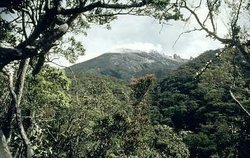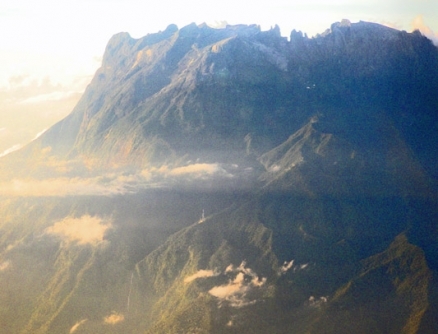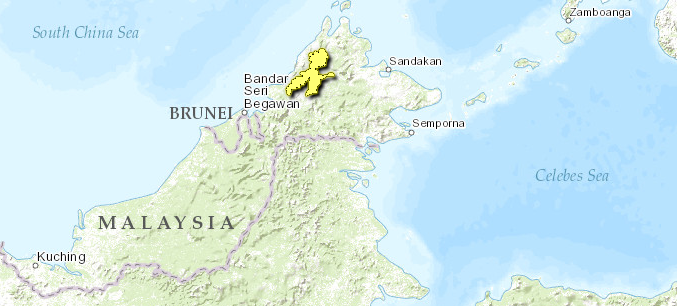Kinabalu montane alpine meadows
The Kinabalu montane alpine meadows are unique to the Indo-Pacific region in that they have been isolated from other mountain chains for many millions of years. This is one of only two ecoregions in the Indo-Pacific region to be globally outstanding for both bird and mammal richness and endemism (the other ecoregion is the Eastern Himalayan broadleaf forests). This montane refuge supports a disjunct distribution of Himalayan, Australasian, and Indomalayan species. Although the very apex of Mount Kinabalu is devoid of vegetation, the slopes and surrounding area have an exceedingly rich flora of approximately 4500 species in more than 180 families with 950 genera. This represents one of the richest concentrations of endemic plant species in the world and is the only Asian example of tropical alpine shrublands with high levels of endemism. This ecoregion supports the greatest concentration of wild orchids on Earth, with more than 750 species in more than sixty genera. This number accounts for more than one quarter of all orchid species found in Malesia.
Location and General Description
This ecoregion represents the upper montane habitat on Mt. Kinabalu and the Crocker Range and the surrounding upland areas in the Malaysian state of Sabah (Borneo). Thirty-five million years ago marine sediments were transformed to rock in the area where Mt. Kinabalu now stands. Approximately 25 million years ago these layers of shale and sandstone were uplifted to form a mountain range. The eroded remains of this range are now known as the Crocker Range. Approximately 15 million years ago a large mass of magma intruded between the folds of the Crocker Range and solidified into adamellite (a type of granite). This intrusion was uplifted rapidly, at a rate of one inch every five years. The exposed granite body, which is still growing, is Mt. Kinabalu. At 13,455 feet it is the highest mountain between the Himalayas and New Guinea. Based on the Köppen climate zone system, this ecoregions meteorology falls in the tropical wet climate zone.
Kinabalu is the meeting place for plant species from the Himalayas, China, Australia, New Zealand, and the Indo-Malayan realm. The vegetation of Kinabalu can be divided into zones based on altitude, but many factors may alter their distribution locally to either higher or lower elevations. Above 1000 meters (m) a montane zone exists until about 2600 m. This zone includes a mixing of lowland and montane families, giving this elevation zone a great diversity (Species diversity) of life. The common lowland families, such as Dipterocarpaceae, Euphorbiaceae, Leuminosae, Myristicaceae, and Sapotaceae, begin to diminish, and they begin to be replaced by a great diversity of species from plant families such as Ericaceae, Myrtaceae, Fagaceae, Lauraceae, Magnoliaceae, and the majority of Bornean gymnosperms, including Podocarpus, Agathis, and Phyllocladus. The dipterocarp Shorea monticola occurs in this elevation belt but not in the lowlands. This elevation zone also supports a number of endemic species from Rhododendron, Lithocarpus, Magnolia, and Rhamnus. A large variety of pitcher plants, many endemic to Mt. Kinabalu, occur in this zone. The endemic species include Nepenthes edwardsiana, N. rajah, N. villosa, and N. burbidgeae. The most common species found in these forests is the spectacular Nepenthes lowii. Fig trees are also common in these forests. Borneo has 135 species of wild figs, with more than 78 species occurring on Kinabalu, including 13 endemic species. Kinabalu may have one of the richest fig floras in the world. This floristically rich area also supports Rafflesia tengku-adlinii (which occurs only on Trus Madi and in the Maliau Basin).
 Mt. Kinabalu, Malaysia. Source: © WWF/Sylvia Yorath Between 2,600 and 3,200 meters is a band of ultrabasic rocks that give rise to a different type of vegetation. This vegetation ranges from the 10-m high Dacrydium gibbsiae to dwarf shrubs and includes moss, lichen, liverwort, and ferns. Above 3,200 m the soil cover soon disappears, giving way to granite. In areas where soil can support shrubs, species such as Leptospermum recurvum, Coprosma hookeri, and Rhododendron buxifolium dominate. On thinner soil, herbs such as Diplocosia kinabaluensis, Machaerarina falcata, and Ranunculus lowii are common.
Mt. Kinabalu, Malaysia. Source: © WWF/Sylvia Yorath Between 2,600 and 3,200 meters is a band of ultrabasic rocks that give rise to a different type of vegetation. This vegetation ranges from the 10-m high Dacrydium gibbsiae to dwarf shrubs and includes moss, lichen, liverwort, and ferns. Above 3,200 m the soil cover soon disappears, giving way to granite. In areas where soil can support shrubs, species such as Leptospermum recurvum, Coprosma hookeri, and Rhododendron buxifolium dominate. On thinner soil, herbs such as Diplocosia kinabaluensis, Machaerarina falcata, and Ranunculus lowii are common.
This ecoregion contains more than 750 orchid species in more than sixty genera. This number accounts for more than one-fourth of all orchid species found in Malesia. Perhaps the most famous orchid species found on Kinabalu are the several species of slipper orchid, Paphiopedilum. However, because of intensive collecting, they are rarely seen. The montane region of Kinabalu presents a variety of microhabitats that have produced many orchid species common to Eria, Bulbophyllum, Dendrobium, Liparis, Dendrochilum, Pholidota, and Coelogyne.
Biodiversity Features
|
Table 1. Endemic and Near-endemic Mammal Species. Family Species Crocidurinae Suncus ater* Sorcidae Crocidura baluensis Tupaiidae Tupaia montana Cercopithecidae Presbytis comata Mustelidae Melogale everetti* Sciuridae Callosciurus baluensis Sciuridae Callosciurus orestes Sciuridae Glyphotes simus Sciuridae Sundasciurus brookei Sciuridae Petaurillus hosei Sciuridae Aeromys thomasi Muridae Rattus baluensis* Muridae Chiropodomys muroides* Muridae Maxomys alticola Muridae Maxomys ochraceiventer Muridae Maxomys baeodon An asterisk signifies that the species range is limited to this ecoregion Most of the 114 mammal species found in this ecoregion (Kinabalu montane alpine meadows) live in the forest canopy. Only one-third of the mammal species are terrestrial. Common terrestrial species include three deer species, the Malaysian weasel (Mustela nudipes), small-clawed otter (Aonyx cinerea), and leopard cat (Felis bengalensis). The majority of the species live in the canopy of the forests. These species include many of the twenty-eight of the thirty-four squirrels known from Borneo, numerous bat species, tree shrews, slow loris, tarsier (Tarsius bancanus), grey leaf monkey (Presbytis aygula), red leaf monkey (P. rubicunda), orangutan (P. pygmaeus), Borneo gibbon (Hylobates moloch), linsang (Prionodon linsang), and binturong (Arctictis binturong). There are twelve near-endemic and four endemic mammal species, which include the Bornean black shrew (Suncus ater) and Bornean ferret-badger (Melogale everetti) (Table 1).
| ||||||||

